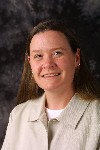 When mothers of young children decide to stay in the work force or stay at home, their beliefs about the appropriate roles for mothers can be as important as economic factors in the decision, says Angela Hattery, assistant professor of sociology at Wake Forest University.
When mothers of young children decide to stay in the work force or stay at home, their beliefs about the appropriate roles for mothers can be as important as economic factors in the decision, says Angela Hattery, assistant professor of sociology at Wake Forest University.
Her new book, “Women, Work and Family: Balancing and Weaving,” examines the ways mothers with young children resolve the job-family conflict. Sage Publications published the book in January 2001.
The Wake Forest sociology department will host a book signing and reception at 3 p.m. Jan. 31 in the Z. Smith Reynolds Library’s Johnson Room. The public is invited.
Hattery interviewed 30 married women, including 10 mothers who stayed at home full-time, 10 mothers who were employed full-time and 10 mothers who were employed part-time. She selected women from various economic groups with various numbers of children, but each of the women had an 18-month-old child at the time of the interviews.
“The interviews suggest that economic need is only one of a host of factors which determine the labor force participation of mothers with young children,” said Hattery.
The data illustrates that mothers resolve the job-family conflict in four different ways based on their beliefs about motherhood or their “motherhood ideology,” Hattery said. She identified four types of mothers: conformists, non-conformists, pragmatists and innovators.
“I hope people can find themselves in these pages and feel validated,” Hattery said. “A lot of women feel that they are the only ones doing it this way. So this is a way of validating multiple options for balancing work and family.”
Conformists believe that the only way to be a good mother is to stay at home. This model of intensive mothering developed in the late 1940s in post -World War II America, Hattery said. Although moms were often home with their children before then, they were not able to devote themselves primarily to childrearing.
“The work of running a household without the help of modern appliances and convenience foods, prevented women from focusing completely on their children,” Hattery said. But, by the 1950s, women began “not staying at home being housewives, but being mothers.”
The conformists are likely to stay at home even when this requires tremendous financial sacrifice.
The non-conformists reject the intensive motherhood ideology, believing that they can work and still be good mothers. They feel a responsibility to provide economically for the family, feel entitled to pursue their own career interests and believe professional childcare benefits their children.
The pragmatists, although they tend to subscribe to the stay-at-home mother model popularized in the 1950s, make their decisions about employment based on practical considerations. With input from their husbands, they conduct a cost-benefit analysis weighing the pros and cons of working. Some decide to work, while others decide to stay at home. The pragmatists tend to idealize fulfilling, well-paying part-time employment, Hattery said. But, many are frustrated about not being able to attain that goal.
The innovators accept the stay-at-home mother ideal, too, but reject the standard methods of achieving a balance between work and family.
“Innovators create new ways of meeting the demands of both their roles as caretakers and economic providers for their families,” Hattery said.
Strategies they use include working shifts that do not overlap with their husbands’ or working from home. Some of the innovators in the study who worked considered themselves stay-at-home moms because they did not use outside childcare. They balanced schedules with fathers and found ways to work without compromising what they saw as their duties as mothers.
The conformists, the non-conformists and the innovators were happy with their decisions to either stay at home or to work despite the financial stress or time pressures they faced. The pragmatists, whether they chose to work or not, were the most dissatisfied with their situations. Pragmatists staying at home full-time felt guilty about not contributing financially to their families and about not pursuing the careers they had worked so hard to attain. Those pragmatists who were employed full-time felt guilty about not spending more time with their children.
“Satisfaction with work situation has more to do with what you think you should be doing than what you actually are doing,” the Wake Forest professor discovered.
Options for child care played a significant role in employment decision-making particularly for the pragmatists, Hattery said. She devotes a book chapter to the various ways child care strategies are selected and created in order for mothers with young children to weave work and family together as seamlessly as possible.
In her interviews with mothers, Hattery also found that employed mothers and stay-at-home mothers were critical of each other’s choices. She hopes the book will help bridge the divide between these women.
“I would love it if women who go to work would understand better those who stay at home, and that women who stay at home would better understand that choice.”
Categories: Faculty, University Announcement
Headlines
Wake Forest in the News
Wake Forest regularly appears in media outlets around the world.




